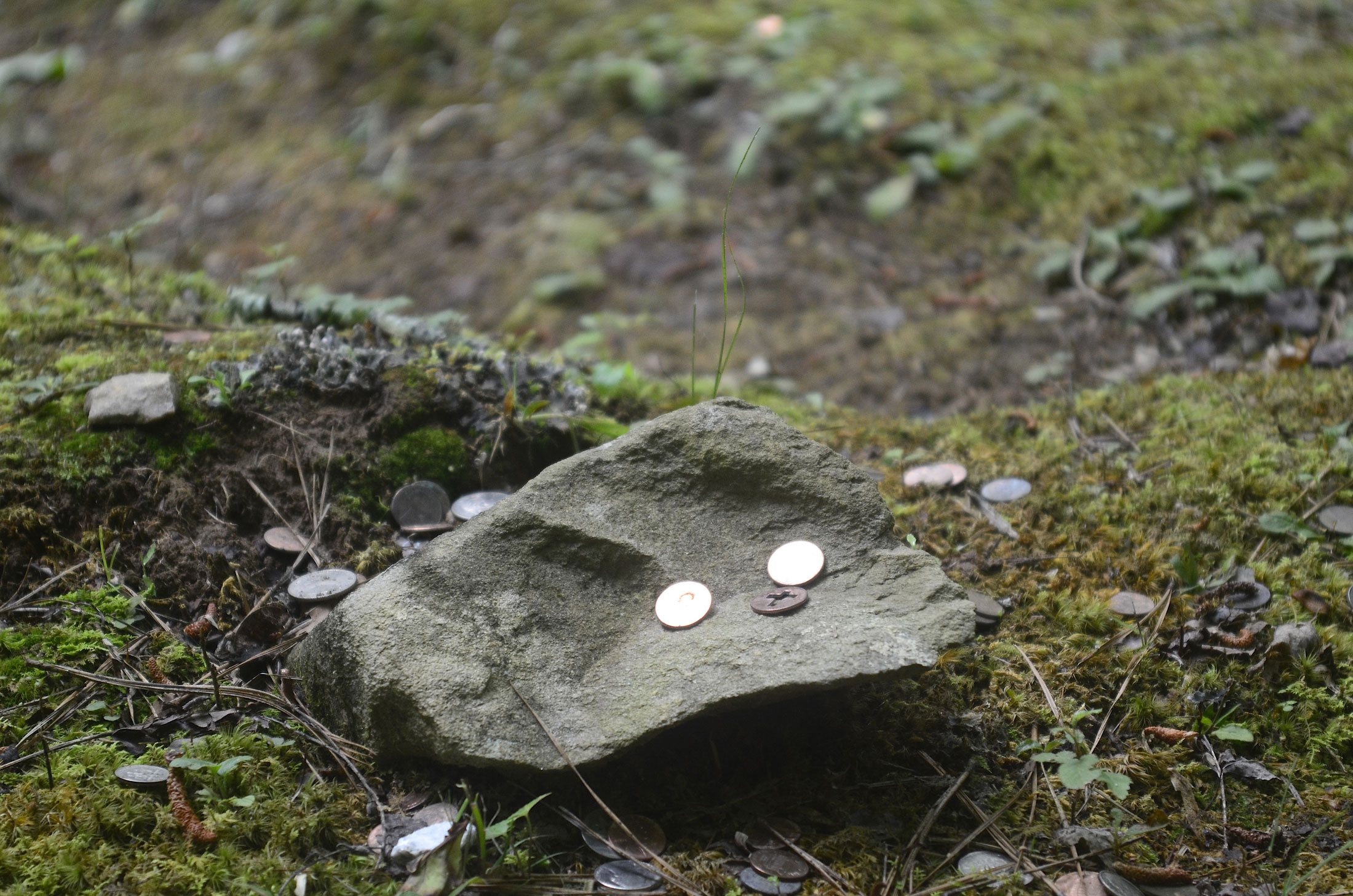
In a shaded clearing near Mingus Mill lies a cemetery. Small, unmarked rocks sit at the head and foot of each plot, adorned with shimmering coins visitors have left as tokens of respect.
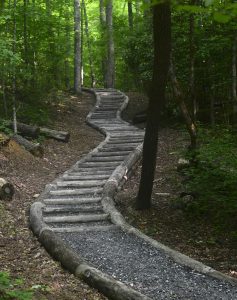
The names, life stories, and even the exact number of people occupying Enloe Cemetery in Great Smoky Mountains National Park have long been lost to history, but interest in this plot of ground has increased in recent years as pieces of the story have come to light. The cemetery is believed to be the final resting place of at least half a dozen Black people who were enslaved by the Mingus family.
In 2023, two new interpretive signs were installed to illuminate the site’s history, and their presence highlighted the need for a better way to reach the cemetery, which sits atop a steep hill. The path from the parking lot was difficult to climb, often slippery, and prone to erosion. Thanks to a $31,600 contribution from park partner Friends of the Smokies, a new access trail has been in place since December 2024.
“The Smokies trail crew did a phenomenal job in creating a sustainable trail to the cemetery along steep and challenging terrain so that future visitors can safely visit and honor the people there, without causing damaging erosion,” said Friends of the Smokies President and CEO Dana Soehn.
At just 150 feet, the trail is quite short, but it presented the park’s skilled trails crew with a worthy challenge. They had originally hoped to reroute the path to achieve a gentler incline but had to abandon that idea due to the potential for resource damage. The park pivoted its plan to use the same footprint as the existing trail, building steps filled with crushed gravel and framed using rot-resistant black locust logs to alleviate erosion issues. Now, visitors can step sure-footed up the hill to reach the cemetery.
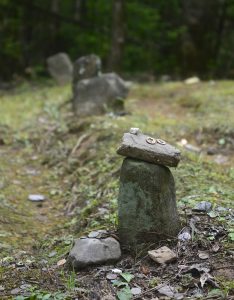
“When people say they don’t like stairs, it’s usually because they’re poorly built and you’re stepping up 12 inches with each stair, so taking care to make lower-rise steps goes a long way,” said Acting Trails Supervisor Adam Monroe. “Aesthetically, using local materials like locust versus something like dimensional lumber is going to go a long way toward people accepting it as blending into the landscape.”
A crew of about five people finished the trail within three weeks. They used chainsaws to cut miter joints, joining the logs together so that the whole construction looks like one solid piece of wood. The final product “really blends into the area,” Monroe said.
The site’s easy-to-reach location also made it valuable as a teaching tool.
“We used it as a mentoring opportunity, because instead of hiking four miles in to reach a project, it’s right there,” Monroe said. “So we were able to use some newer folks and help teach them the construction methods.”
The new trail is the latest milestone in an ongoing effort to uncover the long-overlooked legacy of the Great Smoky Mountains’ Black residents. Funded by Smokies Life, one of the park’s four official partners, this research has been ongoing since 2018 under the auspices of the African American Experiences in the Smokies Project (AAESP). The work has turned up a treasure trove of stories and connections catalogued on the park website, now woven into many wayside signs and interpretive programs.
Friends of the Smokies has also supported the effort. In addition to making the trail possible, the organization funded the new signs at Enloe Cemetery as well as ground-penetrating radar studies to better understand who is buried at Enloe and other African American cemeteries in the Smokies.
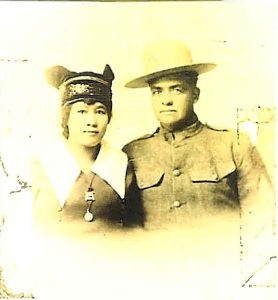
The project has turned up some surprising connections.
“Growing up, I did not envision myself or other Black people in the stereotype of what Appalachia is,” said Natrieifia Miller, education technician for the park and a native of the Piedmont region of North Carolina.
Through the AAESP, she’s come to know that both free and enslaved Black people thrived in these mountains—albeit in smaller numbers than their White or Native counterparts—and that they created one of the region’s most iconic sounds. A blend of African and European traditions, the banjo was “exclusively known as an African American tradition with West African influences” through the 1830s, according to the Smithsonian Institution.
“It’s become one of my passions, to try and get people out here who are like me, who had no concept of the National Park, and if they did, didn’t realize they could find connections in that space,” Miller said.
One person who discovered previously unexplored connections to the Smokies through the AAESP was blues and jazz musician Eric Mingus.
“I’d always heard about Mingus Mill and this area, but it wasn’t exactly a place we felt we had a piece of,” Mingus told Smokies Life in 2023, when he visited Enloe Cemetery with legendary cellist Yo-Yo Ma to perform a song he’d written inspired by the people buried in the cemetery. “Historically, this was the place my grandfather fled.”
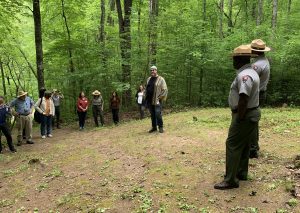
Eric Mingus is the great-grandson of Daniel Mingus, a man whose early years were spent enslaved by the Mingus family, the White family that once owned the land where the cemetery lies. Daniel Mingus continued working for the family after slavery was abolished, and in 1870 he married a White woman named Sarah. By 1880 the couple had five sons.
Eric Mingus’ grandfather Charles Mingus, however, was born around 1877 following an extramarital affair with Clarinda Mingus, a 19-year-old White woman. When Charles was six years old, his mother married and moved to Sevier County, Tennessee, leaving him to be raised by his grandfather John Mingus, a White man.
This was evidently a difficult upbringing for Charles, who left home when he was just 14 years old and returned only once, for a visit in his early 20s. At age 16, he enlisted in the US Army and began a long military career, including about 20 years in the 24th Infantry Regiment, a segregated Black regiment known as the Buffalo Soldiers.
Charles Mingus was stationed at a variety of sites throughout the American West, and while in New Mexico he married a woman named Mary Taylor, with whom he had two children. They later divorced, and the children stayed with their mother. Soon afterwards, Charles Mingus married Harriet Sophia Phillips, a woman of African and Chinese heritage. Shortly after bearing their third child and moving the family to Los Angeles, California, Harriet died of myocarditis, an inflammation of the heart muscle.
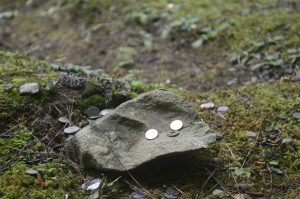
Their youngest child, Charles Mingus Jr., would grow up to become a pivotal figure in 20th-century American music, a renowned bass player, pianist, bandleader, and composer who played and recorded with leading musicians from the 1950s until his death in 1979, at the age of 56.
Uncovering the Daniel Mingus family story doesn’t dispel the mystery surrounding the identities of the people buried at Enloe Cemetery, as Daniel Mingus is not believed to be among them—he is likely buried in the Cowee community of Macon County, North Carolina, about 18 miles away as the crow flies. But it does point to the richness and complexity of the legacies those humble headstones memorialize. With the new trail in place, those connections are more accessible than ever.
Learn more about the African American Experiences in the Smokies Project at NPS.gov/grsm/learn/historyculture/african-american-experiences-in-the-smokies-project.htm. To learn more about how Black musicians have contributed to the songs of Southern Appalachia, check out the Smokies Life mini-series Sepia Tones, available through most major streaming services as part of the Smoky Mountain Air podcast.
Subscribe to get the latest posts sent to your email.
The Great Smokies Welcome Center is located on U.S. 321 in Townsend, TN, 2 miles from the west entrance to Great Smoky Mountains National Park. Visitors can get information about things to see and do in and around the national park and shop from a wide selection of books, gifts, and other Smokies merchandise. Daily, weekly, and annual parking tags for the national park are also available.